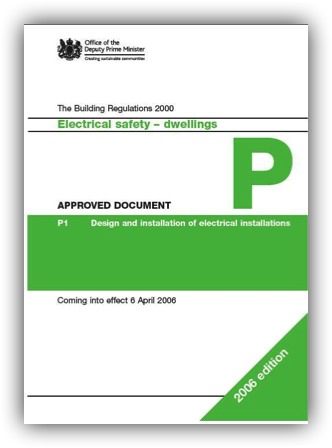
What is Part P?
The term 'Part P' refers to the building regulations approved document P. It was introduced by Government on 1st January 2005. The reason it's known as Part P is just because there were already other documents relating to fire safety, ventilation, drainage and a host of other topics. These had got as far as Part N and they decided not to use Part O!
The aim of this regulation was to reduce the risk of electric shock when using electricity.
So, what does that mean for me?
Prior to the introduction of the Part P document, there was no legal requirement in place regarding electrical installations in domestic dwellings. This meant that as well as qualified electricians doing the job properly, there were many unqualified tradesmen also working on the electrics within people's homes. Qualified electricians have worked to the previously non legally binding IET Wiring Regulations which have been in place since 1882.
Many unqualified folk were not working using the IET wiring regulations which were designed to reduce the risk of shock when using electricity (exactly what Part P now states). This may have left the installation unsafe.
What changed then?
With the introduction of Part P the way electrical installations could be installed changed meaning that no unqualified electricians were able to work on domestic dwellings unless the work was signed off by building control.
If an unqualified person is to work on the electrical installation in someone's home, they need to notify building control before undertaking most work and pay a fee to them to sign off the work once it has been completed (currently £208.63, in Brighton and Hove). If the work does not comply with the regulations, they then have to correct the work and re-pay to have the work reinspected again. This makes the process expensive, and to make themselves cheaper, many unqualified people will simply avoid this necessity meaning no certificate will get issued.
Using an electrician that has joined one of the Government approved schemes (such as Elecsa, Napit or NICEIC) means that the work they carry out can be certified without the cost of notifying building control and you can guarantee to get the certificate at the end of the job.
If an unqualified person is to work on the electrical installation in someone's home, they need to notify building control before undertaking most work and pay a fee to them to sign off the work once it has been completed (currently £208.63, in Brighton and Hove). If the work does not comply with the regulations, they then have to correct the work and re-pay to have the work reinspected again. This makes the process expensive, and to make themselves cheaper, many unqualified people will simply avoid this necessity meaning no certificate will get issued.
Using an electrician that has joined one of the Government approved schemes (such as Elecsa, Napit or NICEIC) means that the work they carry out can be certified without the cost of notifying building control and you can guarantee to get the certificate at the end of the job.
Who can join a Government approved scheme?
To join one of the schemes an electrician has to pass examinations proving they understand the regulations to work to. They also have to undergo yearly assessments of their work and knowledge of the ever changing regulations. They also have to have public liability insurance (minimum of £2 million). They also have to have the correct testing equipment which needs regular calibration to ensure readings are correct. There is quite a hefty cost associated with becoming registered and obviously there is a requirement to know what you are doing, so those who aren't up to the job don't join!
How do I know the electrician I want to use is competent?
Any competent electrician will be able to show you that they are a member of one of the Government approved schemes. If they can't supply you with that information, then they aren't qualified and you should not use them. You can check their credentials on the website of the scheme they belong to.
Just sounds like red tape to me!
To put it into perspective, each year around 12,500 house fires, 750 serious injuries and 10 deaths are caused by unsafe electrics in the home. This is why Part P was brought into being. It's quite shocking (pardon the pun) that so many incidents occur every year when most could easily be avoided by ensuring the work is safe.
I'm still not convinced!
Ok, if you don't follow the regulations you will have no certificate to prove the work was done by a qualified electrician or passed by building control. You may have problems selling your house because of this or it may invalidate your house insurance (since the regulations were brought in the cable colours used have changed from the old red and black to blue and brown, called harmonised colours). If there is blue and brown wiring in the house and no certificate, it's likely that it hasn't been signed off.
My house has the new coloured wiring but I have no certificate, should I worry?
It might be wise to get an electrician in to have a look at the existing installation, they will be able to test it and issue an Electrical Installation Condition Report (previously known as a Periodic Inspection Report or PIR) which will let you know the state of the existing fixed wiring and accessories.
Copyright © 2012. G and O Electrical Installations Limited. Registered in England. Registered Number 07991247.
Elecsa Registration number 56889.









